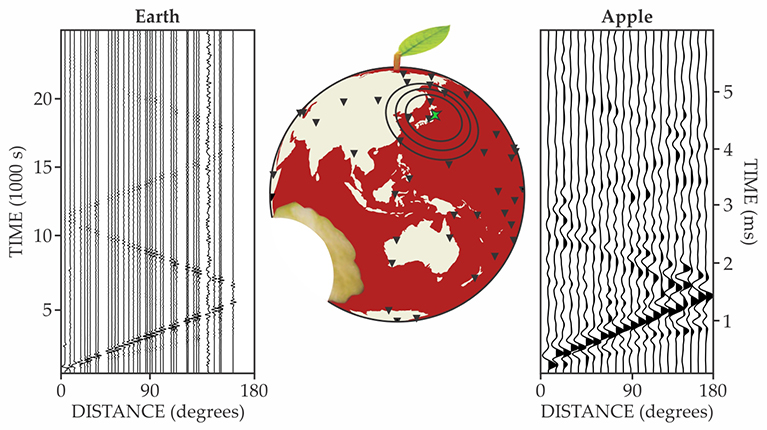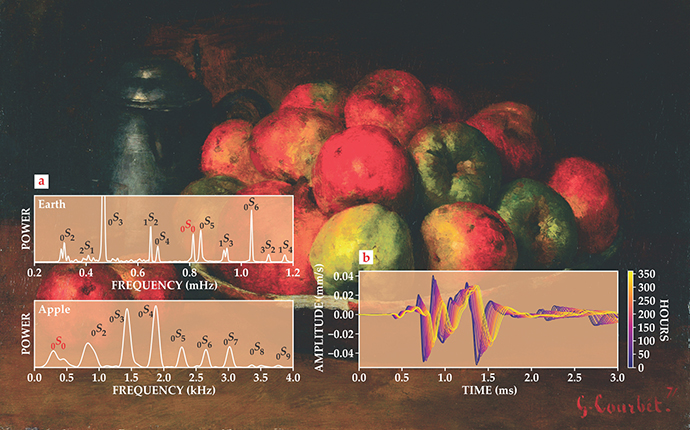Apple seismology
DOI: 10.1063/PT.3.3740
An apple, like Earth, has a core at its center and a thin skin on the outside. In between is the apple’s flesh, equivalent to Earth’s mantle. Of course, a more careful comparison would uncover important differences between those spheroidal objects. For example, seismic waves reveal that Earth’s core is made of a liquid outer core and a solid inner core, whereas the apple core contains seeds that can be surrounded by air. The full interior of our planet cannot be directly sampled, so its properties must be inferred from indirect measurements, such as of seismic waves. An apple can be sampled as a whole, but typically the process destroys the apple. We and our colleagues are developing apple seismology as a nondestructive alternative to monitor the freshness and other properties of the fruit. Our work is still in its early stages, but we hope to continue to refine our techniques to develop a method that is competitive in cost, speed, and reliability with conventional techniques.
Wave propagation
On 11 March 2011, seismic stations around the globe recorded ground displacement due to seismic waves excited by the devastating Tohoku earthquake in Japan. The zigzag pattern in the left panel of figure
Figure 1.

Seismic waves in a spheroid. Stations indicated by triangles in the central panel recorded seismic waves created by the 2011 Tohoku earthquake in Japan. The resulting waveforms are shown to the left. Distance is measured from the origin of the quake. The right panel shows “seismic” waves recorded after a Braeburn apple was excited by a short laser pulse.

A similar pattern in the right panel of figure
Normal modes
The interference of propagating waves on guitar strings or saxophone windpipes can result in standing waves. The interference of propagating waves in a body such as an apple or Earth also results in standing waves, whose distinct patterns of motion are called normal modes. Destructive interference leads to nodes, locations where the amplitude of vibration is zero; constructive interference yields high-amplitude antinodes.
In solids, the so-called spheroidal modes, typically denoted by an “S,” represent radial particle motion. Subscripts define the number of longitudinal and latitudinal nodal lines—that is, lines of zero displacement. The fundamental spherical mode, 0S0, is an in-and-out breathing of the volume as a whole and contains no nodal lines. The 0S2 mode, with zero longitudinal and two latitudinal nodal lines, makes the body resemble a rugby football alternately aligned with the poles and the equatorial plane. Modes with larger values of n vibrate at higher frequencies and sample regions closer to the surface than do the low-n modes.
The top panel of figure
Figure 2.

Normal modes, normal aging. Peaks in the power spectral density (a) reveal the normal modes of vibration for Earth and an apple, which are analogous to a musical instrument’s harmonics. Subscripts describe the nodal structure of the modes. Power is given in arbitrary units. (b) Wave fields in an aging apple (color bar) show that the amplitude and propagation speed fall as the apple loses freshness. (Background: Still Life with Apples and a Pomegranate, Gustave Courbet, 1871.)

The observed resonant modes in Earth and the apple align reasonably well with those predicted by spheres with suitable average properties. The differences in the Earth and apple mode spectra highlight important differences in the bodies’ internal structures. Earth’s breathing mode 0S0 is at a higher frequency than its football mode 0S2 because wave speeds in Earth generally increase with depth. The lowest frequency resonance in the apple is the breathing mode 0S0, which senses the lower-than-average wave speeds in the apple’s core. In addition, the higher-frequency 0S2 mode is broader and slightly offset compared with the best-fitting peak predicted with homogeneous spheres; the discrepancies confirm that the elastic properties of an apple vary with depth.
As an apple ages
From our “seismic analysis” of waves in an apple, we can estimate average elastic properties. Young’s modulus, for example, is closely related to the firmness index, a commonly used parameter in the apple industry to quantify apple firmness. With the laser source and receiver fixed to be 170° apart, we recorded the wave field in our apple every day for 15 days. Figure
References
► J. R. Cooke, R. H. Rand, “A mathematical study of resonance in intact fruits and vegetables using a 3-media elastic sphere model,” J. Agric. Eng. Res. 18, 141 (1973). https://doi.org/10.1016/0021-8634(73)90023-1
► C. B. Scruby, L. E. Drain, Laser Ultrasonics: Techniques and Applications, Adam Hilger (1990).
► S. Stein, M. Wysession, An Introduction to Seismology, Earthquakes, and Earth Structure, John Wiley & Sons (2013).
► S. Hitchman, K. van Wijk, Z. Davidson, “Monitoring attenuation and the elastic properties of an apple with laser ultrasound,” Postharvest Biol. Technol. 121, 71 (2016). https://doi.org/10.1016/j.postharvbio.2016.07.006
More about the Authors
Kasper van Wijk is an associate professor and Sam Hitchman is a PhD candidate in the department of physics at the University of Auckland in New Zealand. Both are affiliated with the Dodd–Walls Centre for Photonic and Quantum Technologies.


